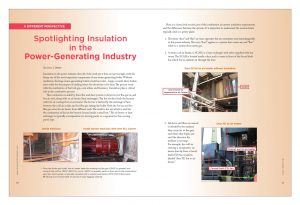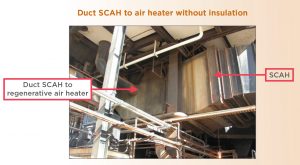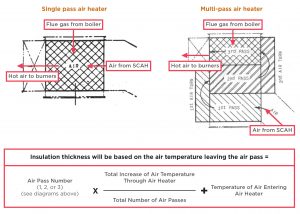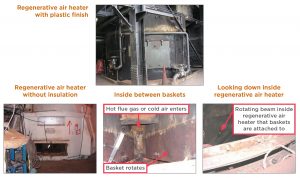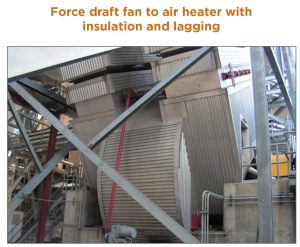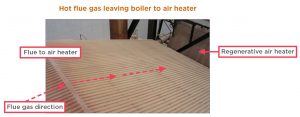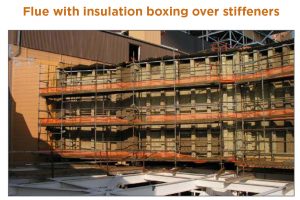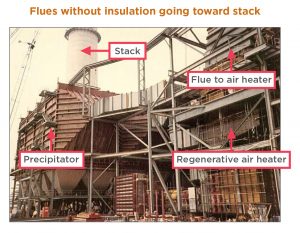A Different Perspective: Spotlighting Insulation in the Power-Generating Industry
Insulation in the power industry does all of the work yet it does not get enough credit for being one of the most important components of any steam-generating boiler. Without insulation, the large steam-generating boilers would not exist. Large or small, these boilers exist solely for the purpose of making steam for electricity or for heat. The process starts with the combustion of fuel (oil, gas, coal, refuse, and biomass). Insulation plays a critical role in the combustion process.
This combustion is aided by three flue and duct systems (cold air in, hot flue gas in, and hot air out), along with an air heater (heat exchanger). The hot air duct feeds the burners
with hot air coming from an air heater. The hot air is derived by the exchange of heat between the cold air intake and hot flue gas exiting the boiler. Both the hot air and hot
flue gas enter the air heater from different ends. The result is hot air, which is used for the combustion of fuel at the burners located inside a wind box.* The air heater or heat exchanger is typically a recuperative (no moving parts) or a regenerative (has moving
parts) type.
* From the boiler gas outlet, the air heater takes the existing hot flue gas (700oF or greater) and converts the cold air (150oF–350oF) to hot air (400oF or greater), which is then sent to the combustion/ wind box. Each system is typically insulated with a mineral wool board ASTM C612 IVB nominal 8# density and covered with an aluminum-type lagging material.
Here is a closer look at each part of the combustion air system insulation requirements and the differences between the systems. It is important to understand the nomenclature typically used at a power plant:
1. The terms “duct” and “flue” are exact opposites but are sometimes used interchangeably in the power industry. The term “duct” applies to a system that carries air, and “flue” refers to a system that carries gas.
2. A steam coil air heater, or SCAH, is a heat exchanger with tubes supplied with hot steam. The SCAH is located inside a duct, and it comes in front of the forced draft fan which forces ambient air through the duct.
3. All ducts and flues are named or labeled by the medium they carry (air or flue gas) and where they begin and end (the direction the medium is moving). For example, the cold air entering a recuperative air heater directly from a forced draft (FD) fan would be labeled “duct FD fan to air heater.”
4. An air heater is a much larger heat exchanger and can be either recuperative (again, one that has no moving parts, such as a tubular air heater) or regenerative (which has moving parts, such as a Ljungstrom and Rothemuhle air heater). Both types are used for heating air that will be used for combustion/burning of fuel.
A recuperative air heater has tubes that are connected to a perforated plate at the top and bottom of a box, with flue gas going through the tubes while air flows around the tubes. The size of the tubular air heater will depend upon the boiler operating conditions. The number of passes the air or gas will make is determined by the temperature of the air required at the burners and space/structural limitations. The insulation thicknesses for each air pass will be based on the air temperature leaving that air pass (see formula below).
A regenerative air heater (RAH) actually has a rotating metal heating surface called baskets. The exchange of heat is due to exposing the metal heating surface to the hot flue gases and transferring/exchanging the heat to the cold air passing over the same metal heating surface. The Ljungstrom has a rotating heating surface and the Rothemuhle has a fixed heating surface with a rotating housing. The insulation thickness is based on the temperature of the flue gas entering the air heater.
Cold Air Duct
The duct SCAH to air heater is usually placed close to the air heater and is one of the few low-pressure ducts of a boiler. The ducts’ external stiffeners are typically shorter and wider spaced due to the duct design pressure. It will require a minimum of insulation to keep or maintain the air temperature from the steam coil outlet to the air heater inlet. Due to the low temperature requirements, the insulation can be installed against the duct plate between the stiffeners and does not have to be installed in a sandwich construction. The outer lagging does not have to be in contact with the insulation.** That makes this duct system the easiest to insulate (and outer lag). The outer lagging can easily be installed over the external stiffeners with only a high-temperature mat-type insulation (½” thick, glued to the stiffener face). This will prevent heat transfer and break the dissimilar metal contact between the aluminum lagging and carbon steel stiffener.
** Sandwich construction is recommended using mineral wool board for insulation applications where the temperature inside a duct or flue is above 350oF. Mineral wool board insulation, when exposed to temperatures above 350oF, can cause the binder inside the insulation to burn out. If the insulation is not in a sandwich construction, the insulation can be lost over time due to vibrations associated with normal boiler operation.
Hot Gas Flue
Hot flue gas is spent gas or gas left over from heating the boiler to make steam for electricity. The hot flue gas starts out in the lower furnace of the boiler at 2500–3000oF and leaves the boiler at the gas outlet around 700oF. The boiler gas outlet flue is usually located above the air heater and is usually designed to be relatively close to the air heater to help minimize heat loss. This hot spent gas is too hot to exit into the stack, so the flue gas temperature must be reduced. Boiler OEM designers use this spent gas to heat air that will be used for the combustion of the fuel in the burners located inside a wind box.
In order to get the hot air to the wind box, hot flue gas must be sent to the air heater. The flue gas is drawn or “induced” into the air heater by the induced fan (ID fan) located down toward or near the stack. This is similar to the FD fan pushing air to the air heater, but in the opposite direction (drawing). However, unlike the cold- or low-temperature duct entering the air heater, the “flue to the air heater” is high temperature and is designed for a higher pressure (water gauge).*** The flue will have larger stiffeners and closer spacing. The temperature requires the flue and its stiffeners to be insulated and installed in a sandwich construction.
*** Flue or duct design for establishing external stiffener sizing and spacing must be designed from a structural standpoint to withstand physical restrictions, gas or air temperature, wind and seismic loading, expansion joint movement, load transfers, and transient pressure that includes water gauge. The physical restrictions, gas temperature, and water gauge will affect the insulation and lagging design.
The flue is difficult to insulate and lag due to the temperature of the flue gas and the size and spacing of the stiffeners. It is also more expensive to install compared to the duct to the air heater. Based on all of the design factors, this flue has three options for an insulation application: bury the stiffeners, humping the stiffeners and covering the insulation with a facing (expanded metal, chicken wire), or using an inner insulation support (22ga corrugated inner lagging).
Hot Air Duct
Finally, after the hot flue gas has passed through the air heater and has exchanged its heat to the temperature of the cold air entering the air heater, it heads toward the wind box. The now-heated hot air (400oF–500oF) is pushed by the FD fan toward and into the wind box. Inside the wind box are burners that will use the hot air for the combustion of the fuel (coal, biomass, refuse). Just like the flue to the air heater, the duct to the wind box has large external stiffeners and must be insulated and lagged. The distance from the air heater to the wind box (which is typically found on both sides of a boiler) is much greater than the flue to the air heater. The average duct to the wind box may be 30–40 ft wide and 20–30 ft high.
Here are some typical square foot areas taken from a Radiant Boiler and a universal pressure boiler:
Radiant Boiler
SCAH 8ft-11”x 16ft-6” x 2 Heaters: 102 square feet
Duct SCAH to Air Heater: 1,559 square feet
Duct Air Heater to Wind Box: 3,008 square feet
Flue Boiler Gas Outlet to SCR: 2,592 square feet
Flue SCR to Air Heater (Right above Air Heater): 1,700 square feet
Universal Pressure Boiler
SCAH 16ft-2”x 19ft-9” x 2 Heaters: 87 square feet
Duct SCAH to Air Heater: 7,061 square feet
Duct Air Heater to Wind Box: 38,421 square feet
Flue Boiler Gas Outlet to SCR: 17,677 square feet
Flue SCR to Air Heater: 12,704 square feet
The square foot areas listed do not take into account the flues and equipment after the air heater going toward the stack. Typically, the square foot area is about the same square foot area of the entire boiler flues and ducts. (See photo below left showing the extent of the flues going to the stack without insulation and lagging.)
The amount of insulation required for the three systems (air in, air out, and flue gas in) is significant. Even today, there is still a lack of understanding as to how important the insulation is and its impact on the combustion of the fuel used in a power boiler. Insulation is essential for efficient boiler operation and the most unappreciated of all the components that make up a steam-generating facility. Without insulation, there would be no large steam-generating boilers and no electricity to power our cities and country.

